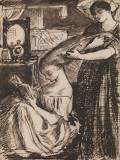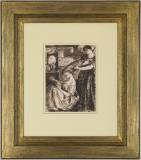This powerful drawing was made by Rossetti in around 1855 and was given by his brother, William Michael Rossetti to the daughter of one of Rossetti’s most important models, the Greek pre-Raphaelite artist Euphrosyne Spartali. Executed boldly in well-preserved dark ink, this small drawing captures Rossetti’s enduring preoccupation with the representation of women’s hair, particularly long hair being combed for dramatic display.
Whilst the precise literary source of this drawing has not yet been identified, it is a motif which reappears in a number of Rossetti’s greatest compositions including his grand watercolour Morning Music now in the Fitzwilliam Museum and his late depiction of Desdemona’s Death Song which was drawn in around 1880. Made early in Rossetti’s career this drawing almost certainly represents a scene modelled by Elizabeth Siddal, the painter and muse, who dominated Rossetti’s art at this date.
Rossetti was the second son of Gabriele Pasquale Giuseppe Rossetti a celebrated Italian scholar of Dante and Frances Mary Lavinia Polidori. A founding member of the Pre-Raphaelite Brotherhood he espoused a new aesthetic and new way of approaching art. In 1852 Rossetti took rooms in Chatham Place, Blackfriars Bridge and began to sell small drawings and watercolours to fellow artists and by 1853 he had his first notable commercial success, selling The Annunciation to the Belfast businessman Francis MacCraken for £50. Rossetti’s personal standing further improved through his meeting with Ruskin who began to champion his works. At this date, Rossetti began to use a number of regular female sitters. The present drawing almost certainly depicts Elizabeth Siddal reading whilst she has her hair combed. Siddal, whose tall stature, dreamy, heavily lidded eyes and long copper-red hair became archetypal features of the ideal Pre-Raphaelite woman. Initially she modelled for a number of painters in Rossetti’s circle, but was rapidly monopolised by Rossetti himself, who, in turn encouraged her aspirations as a painter and poet. During the 1850s Siddal, who became known as ‘Guggums’, ‘the Sid’ or ‘the Dove’, posed frequently for Rossetti’s paintings. On seeing a draw full of studies of Siddal, Ford Madox Brown observed: ‘Gabriel… drawing wonderful and lovely ‘Guggums’ one after another each one a fresh charm each one stamped with immortality. God knows how many, it is like a monomania with him.’
This heavily worked interior scene is characteristic of Rossetti in around 1855. A mass of hatched, pen lines give a claustrophobic quality to the composition. The densely worked quality is one that Rossetti was experimenting with at this date, filling almost every part of the sheet with pen lines. Rossetti has included a circular mirror on a dressing-table beyond the seated reading woman, the two figures visible in the reflection of the glass. Beyond Rossetti has shown a curtained bed, similar to those found in early Netherlandish paintings, suggesting that this drawing is a study for a historical or literary scene. Rossetti’s brother, William Michael Rossetti suggested, in a note on the verso of the sheet, that this drawing was made into a watercolour demands greater research, currently no such watercolour can be identified. It was William Michael Rossetti who was responsible for dispersing Rossetti’s estate and the present drawing was given to Effie Ritchie in 1905. Effie was the daughter of the great Pre-Raphaelite model and painter Euphrosyne Spartali. Rossetti was fond of the young girl describing her as ‘the divinely lovely Effie’, she appears in rich Renaissance costume in an 1879 portrait entitled La Pensierosa by her mother. Jane Morris stated simply that ‘Effie is beautiful.’ The drawing remained in the Ritchie family until sold in 2012 and was consequently unknown to Surtees.



